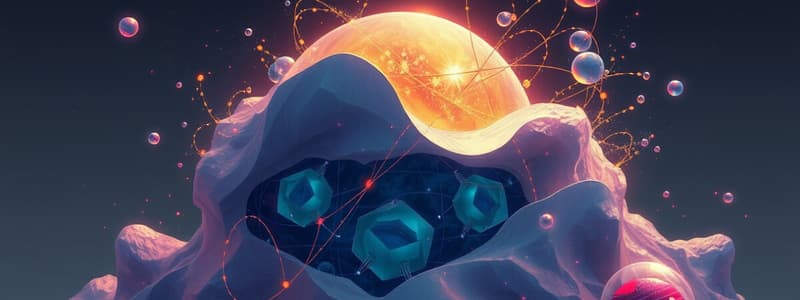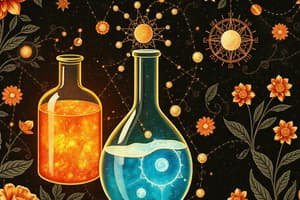Podcast
Questions and Answers
What is the value of one mole in terms of particles?
What is the value of one mole in terms of particles?
- 3.011 x 10²³ particles
- 9.440 x 10²³ particles
- 6.022 x 10²³ particles (correct)
- 1.204 x 10²³ particles
Which of the following describes an endothermic reaction?
Which of the following describes an endothermic reaction?
- Does not involve heat transfer
- Results in an increase in temperature of the surroundings
- Absorbs heat from the surroundings (correct)
- Releases heat to the surroundings
What is the role of the solvent in a solution?
What is the role of the solvent in a solution?
- To maintain the system at equilibrium
- To dissolve the solute (correct)
- To provide chemical reactions
- To increase the solute's boiling point
What occurs at chemical equilibrium?
What occurs at chemical equilibrium?
How is molar mass defined?
How is molar mass defined?
Which of the following describes matter?
Which of the following describes matter?
What kind of bond is formed through the transfer of electrons?
What kind of bond is formed through the transfer of electrons?
Which of the following statements about solids is true?
Which of the following statements about solids is true?
What is the mass number of an atom?
What is the mass number of an atom?
In a chemical reaction, the substances that undergo a change are known as what?
In a chemical reaction, the substances that undergo a change are known as what?
Which group of elements typically conducts electricity well?
Which group of elements typically conducts electricity well?
What is the pH range of acids?
What is the pH range of acids?
Which of the following reactions involves the exchange of ions between two compounds?
Which of the following reactions involves the exchange of ions between two compounds?
Flashcards are hidden until you start studying
Study Notes
Basic Concepts of Chemistry
- Matter: Anything that has mass and occupies space.
- Elements: Pure substances that cannot be broken down (e.g., hydrogen, oxygen).
- Compounds: Substances formed from two or more elements chemically combined (e.g., water, CO2).
- Mixtures: Physical combinations of two or more substances (e.g., air, salad).
States of Matter
- Solid: Definite shape and volume; particles are closely packed.
- Liquid: Definite volume but takes the shape of the container; particles are less tightly packed.
- Gas: No definite shape or volume; particles are far apart and move freely.
Atomic Structure
- Atom: The smallest unit of an element.
- Subatomic Particles:
- Protons: Positively charged, located in the nucleus.
- Neutrons: Neutral, also in the nucleus.
- Electrons: Negatively charged, orbit the nucleus in electron shells.
- Atomic Number: Number of protons in an atom; defines the element.
- Mass Number: Total number of protons and neutrons.
Chemical Bonds
- Ionic Bonds: Formed between metals and non-metals through the transfer of electrons.
- Covalent Bonds: Formed between non-metals through the sharing of electrons.
- Metallic Bonds: Occur between metal atoms; electrons are shared in a "sea" of electrons.
Chemical Reactions
- Reactants: Substances that undergo a chemical change.
- Products: New substances formed from the reaction.
- Types of Reactions:
- Synthesis: Two or more substances combine to form a new compound.
- Decomposition: A compound breaks down into simpler substances.
- Single Replacement: One element replaces another in a compound.
- Double Replacement: Exchange of ions between two compounds.
- Combustion: Reaction with oxygen, producing heat and light.
The Periodic Table
- Groups/Families: Vertical columns; elements have similar properties.
- Periods: Horizontal rows; properties change progressively.
- Metals, Nonmetals, and Metalloids:
- Metals: Good conductors, malleable, ductile.
- Nonmetals: Poor conductors, brittle, diverse states.
- Metalloids: Exhibit properties of both metals and nonmetals.
Acids and Bases
- Acids: Substances that donate protons (H+) in a solution; pH < 7.
- Bases: Substances that accept protons or donate hydroxide ions (OH-); pH > 7.
- Neutralization: Reaction between an acid and a base to produce water and salt.
Stoichiometry
- Mole: A unit for counting particles (6.022 x 10²³ particles).
- Molar Mass: Mass of one mole of a substance (g/mol).
- Balancing Equations: Ensures the law of conservation of mass; same number of each atom on both sides.
Thermochemistry
- Endothermic Reactions: Absorb heat from the surroundings.
- Exothermic Reactions: Release heat to the surroundings.
- Enthalpy (ΔH): Heat content of a system at constant pressure.
Solutions
- Solvent: The substance that dissolves the solute (e.g., water).
- Solute: The substance being dissolved (e.g., salt).
- Concentration: Amount of solute in a given volume of solution.
Kinetics and Equilibrium
- Reaction Rate: Speed at which reactants are converted to products.
- Equilibrium: The point at which the rate of the forward reaction equals the rate of the reverse reaction.
- Le Chatelier's Principle: If a system at equilibrium is disturbed, it will shift to counteract the disturbance.
Basic Concepts of Chemistry
- Matter is anything with mass that occupies space.
- Elements are pure substances that cannot be broken down further (e.g., hydrogen, oxygen).
- Compounds are substances formed from two or more elements chemically combined (e.g., water, CO2).
- Mixtures are physical combinations of two or more substances, such as air and salad.
States of Matter
- Solids have a definite shape and volume, with particles closely packed together.
- Liquids have a definite volume but take the shape of their container, with less tightly packed particles.
- Gases have no definite shape or volume; their particles are far apart and move freely.
Atomic Structure
- An atom is the smallest unit of an element, composed of subatomic particles.
- Protons are positively charged particles located in the atomic nucleus.
- Neutrons, found in the nucleus, are neutral particles with no charge.
- Electrons are negatively charged particles that orbit the nucleus in electron shells.
- The atomic number indicates the number of protons in an atom, defining the element.
- The mass number represents the total count of protons and neutrons in the nucleus.
Chemical Bonds
- Ionic bonds occur through the transfer of electrons between metals and non-metals.
- Covalent bonds form through the sharing of electrons between non-metals.
- Metallic bonds involve a "sea" of delocalized electrons shared among metal atoms.
Chemical Reactions
- Reactants are the starting substances in a chemical reaction that undergo a change.
- Products are the new substances produced as a result of the reaction.
- Types of reactions include:
- Synthesis: Two or more substances combine to form a new compound.
- Decomposition: A compound breaks down into simpler substances.
- Single Replacement: One element substitutes for another in a compound.
- Double Replacement: Ions in two compounds exchange places.
- Combustion: A reaction with oxygen that produces heat and light.
The Periodic Table
- Groups (or families) are vertical columns where elements share similar properties.
- Periods are horizontal rows where properties of elements change progressively.
- Metals are typically good conductors, malleable, and ductile.
- Nonmetals are generally poor conductors, brittle, and can be found in diverse states.
- Metalloids possess characteristics of both metals and nonmetals.
Acids and Bases
- Acids are substances that donate protons (H+) in solution, typically having a pH less than 7.
- Bases accept protons or donate hydroxide ions (OH-), usually exhibiting a pH greater than 7.
- Neutralization is the reaction between an acid and a base, producing water and salt.
Stoichiometry
- A mole is a unit used for counting particles, defined as 6.022 x 10²³ particles.
- Molar mass represents the mass of one mole of a substance, expressed in grams per mole (g/mol).
- Balancing chemical equations ensures the law of conservation of mass is maintained, matching the number of each atom on both sides.
Thermochemistry
- Endothermic reactions absorb heat from their surroundings, leading to a temperature drop in the environment.
- Exothermic reactions release heat into the surroundings, causing a temperature increase.
- Enthalpy (ΔH) refers to the heat content of a system measured at constant pressure.
Solutions
- The solvent is the substance that dissolves the solute (e.g., water).
- The solute is the substance that gets dissolved (e.g., salt).
- Concentration indicates the amount of solute present in a given volume of solution.
Kinetics and Equilibrium
- Reaction rate defines how quickly reactants are converted into products.
- Equilibrium occurs when the forward and reverse reaction rates are equal, maintaining a stable condition.
- Le Chatelier's Principle states that if an equilibrium system is disturbed, it will shift to counteract that disturbance.
Studying That Suits You
Use AI to generate personalized quizzes and flashcards to suit your learning preferences.




